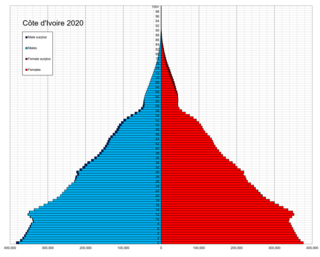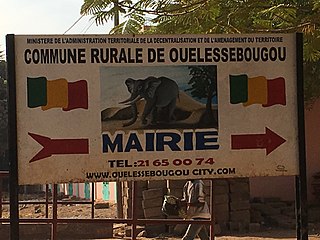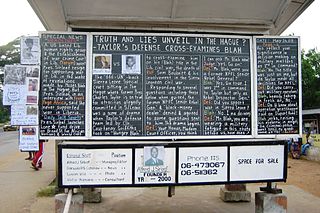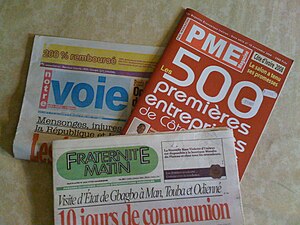
Demographic features of the population of Ivory Coast include population density, ethnicity, education level, health of the populace, economic status, religious affiliations and other aspects of the population.

Dyula is a language of the Mande language family spoken mainly in Burkina Faso, Ivory Coast and Mali, and also in some other countries, including Ghana, Guinea and Guinea-Bissau. It is one of the Manding languages and is most closely related to Bambara, being mutually intelligible with Bambara as well as Malinke. It is a trade language in West Africa and is spoken by millions of people, either as a first or second language. Similar to the other Mande languages, it uses tones. It may be written in the Latin, Arabic or N'Ko scripts.

Hausa is a Chadic language that is spoken by the Hausa people in the northern parts of Nigeria, Ghana, Cameroon, Benin and Togo, and the southern parts of Niger, Chad and Sudan, with significant minorities in Ivory Coast.

The Senufo or Senufic languages has around 15 languages spoken by the Senufo in the north of Ivory Coast, the south of Mali and the southwest of Burkina Faso. An isolated language, Nafaanra, is also spoken in the west of Ghana. The Senufo languages constitute their own branch of the Atlantic–Congo sub-family of the Niger–Congo languages. Garber (1987) estimates the total number of Senufos at some 1.5 million; the Ethnologue, based on various population estimates, counts 2.7 million. The Senufo languages are bounded to the west by Mande languages, to the south by Kwa languages, and to the north and east by Central Gur languages.
Baoulé, also known as Baule or Bawule, is a language spoken in central and southern Ivory Coast, including in the regions of Lacs, Lagunes, Gôh-Djiboua, Sassandra-Marahoué, Vallée du Bandama, Woroba, and Yamoussoukro, by approximately 5.3 million people. It is a Kwa language of the Central Tano branch, forming a dialect continuum with Anyin and closely related to Nzema and Sehwi. It is the common language of the Baoulé people, the largest ethnic group in Ivory Coast.

Bobo-Dioulasso is a city in Burkina Faso with a population of 1,129,000 ; it is the second-largest city in the country, after Ouagadougou, Burkina Faso's capital. The name means "home of the Bobo-Dioula".

The Manding languages are a dialect continuum within the Niger-Congo family spoken in West Africa. Varieties of Manding are generally considered to be mutually intelligible – dependent on exposure or familiarity with dialects between speakers – and spoken by 9.1 million people in the countries Burkina Faso, Senegal, Guinea-Bissau, Guinea, Mali, Liberia, Ivory Coast and the Gambia. Their best-known members are Mandinka or Mandingo, the principal language of The Gambia; Bambara, the most widely spoken language in Mali; Maninka or Malinké, a major language of Guinea and Mali; and Jula, a trade language of Ivory Coast and western Burkina Faso. Manding is part of the larger Mandé family of languages.

Bouaké is the second-largest city in Ivory Coast, with a population of 740,000. It is the seat of three levels of subdivision—Vallée du Bandama District, Gbêkê Region, and Bouaké Department. The city is located in the central part of Ivory Coast about 50 kilometres (31 mi) northeast of Lake Kossou, the country's largest lake. It is approximately 350 kilometres (220 mi) north of Abidjan on the Abidjan-Niger Railway and about 100 kilometres (62 mi) northeast of Yamoussoukro, the capital of the country.

Mali is a multilingual country of about 21.9 million people. The languages spoken there reflect ancient settlement patterns, migrations, and its long history. Ethnologue counts more than 80 languages. Of these, Bambara, Bobo, Bozo, Dogon, Fula, Hassaniya, Kassonke, Maninke, Minyanka, Senufo, Songhay languages, Soninke and Tamasheq are official languages. French is the working language.
Bozo is a Mande language spoken by the Bozo people of the Inner Niger Delta in Mali. For Fishing, many Bozo are also found in other West African countries where there are Rivers and Dams, such as Nigeria, Burkina Faso and the Ivory Coast. According to the 2000 census, the Bozo people number about 132,100. Bozo is considered a dialect cluster, but there is a quite a bit of diversity. Ethnologue recognises four languages on the basis of requirements for literacy materials. Bozo is part of the northwestern branch of the Mande languages; the closest linguistic relative is Soninke, a major language spoken in the northwestern section of southern Mali, in eastern Senegal, and in southern Mauritania. The Bozo often speak one or more regional languages such as Bambara, Fula, or Western Songhay. The language is tonal, with three lexical tones.

Ghana is a multilingual country in which about eighty languages are spoken. Of these, English, which was inherited from the colonial era, is the official language and lingua franca. Of the languages indigenous to Ghana, Akan is the most widely spoken in the south. Dagbani is most widely spoken in the north.

There are over 525 native languages spoken in Nigeria. The official language and most widely spoken lingua franca is English, which was the language of Colonial Nigeria. Nigerian Pidgin – an English-based creole – is spoken by 30 million people in Nigeria.
Busa, or Bisã, is the Mande language of the former Borgu Emirate in northwestern Nigeria and northern Benin. It is called Busanci in Hausa, and has also been called Zugweya.

Benin is a diverse country linguistically. Of those, French is the official language, and most of the indigenous languages are considered national languages.

Burkina Faso is a multilingual country. An estimated 70 languages are spoken there, of which about 66 are indigenous. Mooré is spoken by about 52.5% of the population, mainly in the central region around the capital, Ouagadougou.

Liberia is a multilingual country where more than 20 indigenous languages are spoken. English is the official language, and Liberian Kreyol is the vernacular lingua franca, though mostly spoken as a second language. The native Niger-Congo languages can be grouped in four language families: Mande, Kru, Mel, and the divergent language Grebo
The Siamou language, also known as Seme (Sɛmɛ), is a language spoken mainly in Burkina Faso. It is part of the Kru languages or unclassified within the proposed Niger–Congo languages. It is also spoken in Ivory Coast and Mali, and could likely be a language isolate.
Ivorian Americans are an ethnic group of Americans of Ivorian descent. According to estimates, in 2014 there were 6,000 people in the United States of Ivorian ancestry.
Daoukro is a town in east-central Ivory Coast. It is a sub-prefecture of and the seat of Daoukro Department. It is also the seat of Iffou Region in Lacs District. Daoukro is also a commune.
Jeri is a cover term for two Mande language of northwestern Ivory Coast and southwestern Burkina Faso. The two had been thought until recently to be dialects of a single language, but they are now known to be clearly distinct. The Burkina language is Jalkunan, and the Ivory Coast language is Jeri Kuo. Jeri Kuo is spoken by people who traditionally constituted a caste-like minority within an otherwise mostly Senufo-speaking zone. The language is thought to be endangered, with 90% of ethnic Jeri having shifted to regionally dominant languages. The Jalkunan-speaking people of the Blédougou village cluster are not people of caste, although nearby villages of other ethnicities have entire sections populated by blacksmith and leatherworker castes. Jalkunan is being replaced by Jula (Dioula), but it is not immediately threatened by extinction.
















